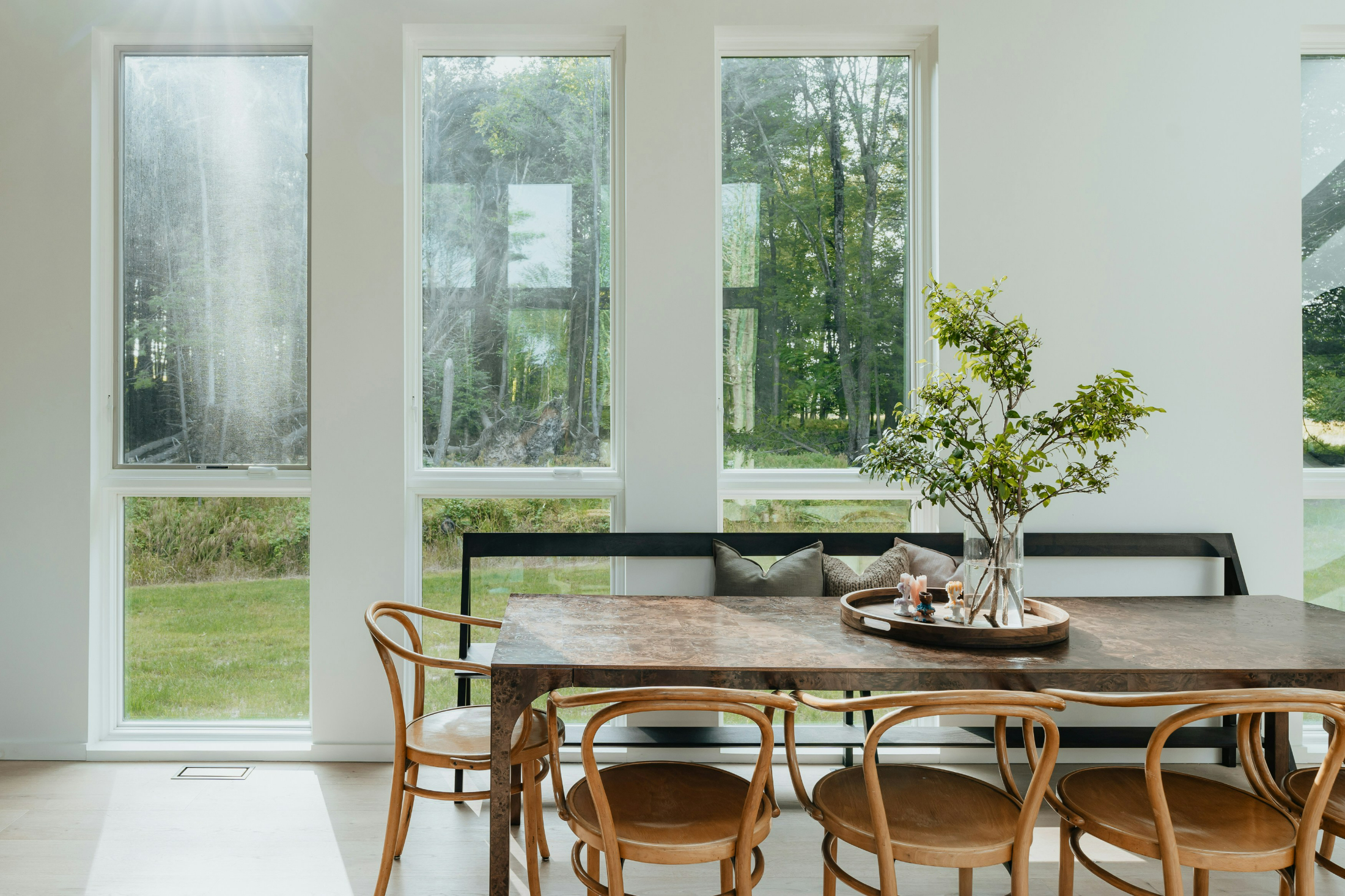As the seasons change and the vibrant colors of autumn start to paint the landscape, homeowners in Victoria, BC, have a chance to prepare their homes for the cooler months ahead. Fall in Victoria is typically a time of mild temperatures and intermittent rain, but the shift in weather brings the opportunity to check in on your home’s to-do list & tackle seasonal chores that may be in need to addressing.
Here are our shortlist of ten essential fall home maintenance items to keep you organized and prepared for the colder days ahead and beyond!
1. Clean Out the Gutters
During the fall, Victoria’s many trees, including the iconic Garry Oaks and maples, shed leaves in abundance. These leaves often find their way into gutters, where they can accumulate, block water flow, and cause drainage issues. Clogged gutters can lead to water damage, as rainwater may overflow and pool around the foundation of the home or seep into areas it shouldn't.
Regularly clearing gutters helps ensure that rainwater flows freely through downspouts and away from the home. While gutter cleaning may not be the most glamorous fall task, it can be one of the most crucial, particularly in a climate like Victoria’s, where rain is common through the fall and winter months.
2. Inspect the Roof for Potential Issues
Victoria may not experience the heavy snowfall of other parts of Canada, but the combination of rain, wind, and occasional freezing temperatures can still impact the health of a roof. Fall is a good time to visually inspect the roof for signs of wear and tear, such as missing or damaged shingles, loose flashing, or any other indicators that repairs might be needed.
The key is to catch minor issues before they become more serious problems during the winter months when water damage could potentially occur. Ensuring that the roof is in good condition can help protect the home from leaks and other water-related issues.
3. Seal Drafts Around Windows and Doors
Fall is an ideal time to check for drafts around windows and doors. As temperatures drop, any gaps or cracks in seals can allow cold air to seep into the home, causing heating systems to work harder and energy bills to rise.
This time of year provides the opportune occasion to inspect seals and weatherstripping for wear and tear, replacing them if needed. Ensuring windows and doors are properly sealed can help maintain a comfortable indoor temperature and improve energy efficiency, ensuring you remain cozy all winter and keeping energy costs down.
4. Test and Service Heating Systems
With winter approaching, it's essential that heating systems are in good working order. There are a variety of heating sources used in Victoria homes such from electric baseboards to gas furnaces to heat pumps and more. Fall is a great time for homeowners to test their heating systems to ensure everything is functioning as expected.
Scheduling a routine inspection with a professional technician can help identify any issues before they become problems. Regular maintenance of heating systems not only ensures a warm and comfortable home during the colder months but can also extend the lifespan of the equipment.
5. Check Smoke and Carbon Monoxide Detectors
With the increased use of heating systems during fall and winter, the risk of fire and carbon monoxide exposure may rise. Smoke detectors and carbon monoxide alarms play a crucial role in keeping both families and homes safe.
Homeowners may want to test these devices to ensure they are working properly, and that batteries are fresh. It's often recommended that homeowners check detectors regularly throughout the year, and fall is no different. By being proactive and cautious, the risk of emergency and accident are greatly reduced.
6. Trim Trees and Bushes
Victoria is known for its beautiful green spaces, and many homes are surrounded by mature trees and lush foliage. As the leaves fall and plants go dormant, homeowners might use this time to prune trees and bushes, particularly those close to the house or power lines.
Trimming back branches not only improves the appearance of the landscape but can also help prevent damage during windstorms, which are not uncommon in the fall. Overhanging branches can scratch windows, damage roofs, or, in more severe cases, cause power outages if they interfere with electrical lines. Fall is an ideal time for pruning before the winter weather sets in.
7. Inspect the Foundation and Exterior Walls
Victoria’s mild yet rainy fall season makes it a good time for homeowners to inspect their home’s foundation and exterior walls for cracks or gaps. Moisture that seeps into these areas could potentially lead to more significant problems, such as structural damage or mold growth.
Homeowners often look for signs of wear, including cracks in the foundation, loose or damaged siding, or gaps in caulking. Taking steps to repair these issues in the fall can help prevent moisture from penetrating the home during the wetter months. In some cases, tree pruning may require a city permit for protected trees under the Tree Protection Bylaw of Victoria, BC. Check with your municipality if this applies to you.
8. Prepare Outdoor Spaces for Winter
Although Victoria experiences milder winters compared to other regions of Canada, it’s still a good idea to prepare outdoor spaces for the cooler months. This could involve tasks such as cleaning and storing patio furniture, draining garden hoses, and shutting off outdoor water sources to prevent freezing.
Outdoor maintenance also includes cleaning and storing any gardening equipment, tidying up landscaping, and removing dead leaves or debris from around the property. Taking these steps helps ensure that outdoor spaces are ready for use when spring arrives.
9. Maintain the Chimney and Fireplace
For those who enjoy the warmth and ambiance of a wood-burning fireplace, fall is the time to ensure the chimney and fireplace are clean and functioning properly. Over time, chimneys can accumulate soot, creosote, and other debris, which can pose fire hazards if not properly maintained.
A professional can conduct a chimney sweep to clean the chimney and inspect it for any structural issues or blockages. Ensuring that the chimney and fireplace are in good condition provides peace of mind for homeowners who plan to use them throughout the colder months.
10. Check for Plumbing Leaks and Insulate Pipes
As temperatures dip, it's not uncommon for homeowners to experience issues with plumbing, particularly in uninsulated or exposed areas. Fall is a good time to check for any existing leaks and take steps to insulate pipes, especially those in basements, crawl spaces, or exterior walls.
Insulating pipes can help prevent them from freezing and bursting during colder temperatures, reducing the risk of water damage in the home. Regularly checking for leaks and addressing any plumbing concerns before winter can help homeowners avoid potentially costly repairs.
Wrapping Up Your Fall Home Maintenance
As the vibrant colors of autumn make way for the cooler, rainier days in Victoria, taking the time to address these essential maintenance tasks can help homeowners prepare their properties for the months ahead. A little effort now can go a long way in preserving the comfort, safety, and efficiency of your home throughout the fall and winter seasons.
If you’re feeling unsure about tackling some of these tasks on your own, or if you prefer leaving certain jobs to the pros, we’ve got you covered. Our team has an extensive network of trusted tradespeople in the Victoria area, from roofers to plumbers, and everything in between. Whether you need help inspecting your chimney, servicing your heating system, or trimming back those unruly branches, feel free to reach out—we’d be happy to recommend a qualified professional to help get your home ready for the colder months ahead.
Your home is your sanctuary, and a little proactive care this fall can make all the difference in keeping it in tip-top shape for seasons to come!
.png)


















